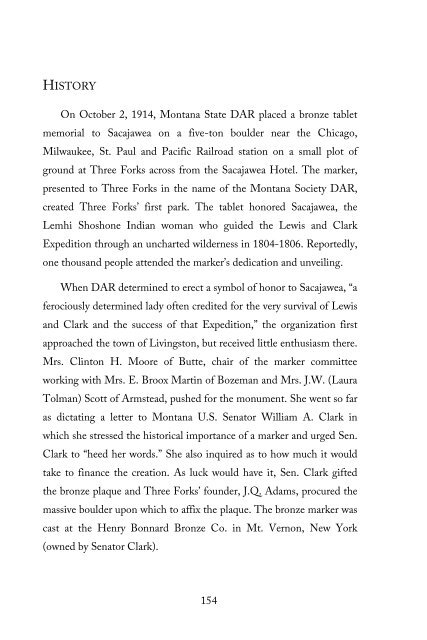Montana's DAR Markers . . . Honoring Where History Was Made
This book is a 200-page thank you to the women of Montana State Society Daughters of the American Revolution for their work in placing historical markers across the state of Montana. Starting in 1908, Montana DAR has installed 70 historical markers across the state. Of those, 33 remain. This book records why the markers’ sites were selected, their history, and the backstory of each.
This book is a 200-page thank you to the women of Montana State Society Daughters of the American Revolution for their work in placing historical markers across the state of Montana. Starting in 1908, Montana DAR has installed 70 historical markers across the state. Of those, 33 remain. This book records why the markers’ sites were selected, their history, and the backstory of each.
Create successful ePaper yourself
Turn your PDF publications into a flip-book with our unique Google optimized e-Paper software.
HISTORY<br />
On October 2, 1914, Montana State <strong>DAR</strong> placed a bronze tablet<br />
memorial to Sacajawea on a five-ton boulder near the Chicago,<br />
Milwaukee, St. Paul and Pacific Railroad station on a small plot of<br />
ground at Three Forks across from the Sacajawea Hotel. The marker,<br />
presented to Three Forks in the name of the Montana Society <strong>DAR</strong>,<br />
created Three Forks’ first park. The tablet honored Sacajawea, the<br />
Lemhi Shoshone Indian woman who guided the Lewis and Clark<br />
Expedition through an uncharted wilderness in 1804-1806. Reportedly,<br />
one thousand people attended the marker’s dedication and unveiling.<br />
When <strong>DAR</strong> determined to erect a symbol of honor to Sacajawea, “a<br />
ferociously determined lady often credited for the very survival of Lewis<br />
and Clark and the success of that Expedition,” the organization first<br />
approached the town of Livingston, but received little enthusiasm there.<br />
Mrs. Clinton H. Moore of Butte, chair of the marker committee<br />
working with Mrs. E. Broox Martin of Bozeman and Mrs. J.W. (Laura<br />
Tolman) Scott of Armstead, pushed for the monument. She went so far<br />
as dictating a letter to Montana U.S. Senator William A. Clark in<br />
which she stressed the historical importance of a marker and urged Sen.<br />
Clark to “heed her words.” She also inquired as to how much it would<br />
take to finance the creation. As luck would have it, Sen. Clark gifted<br />
the bronze plaque and Three Forks’ founder, J.Q. Adams, procured the<br />
massive boulder upon which to affix the plaque. The bronze marker was<br />
cast at the Henry Bonnard Bronze Co. in Mt. Vernon, New York<br />
(owned by Senator Clark).<br />
154





